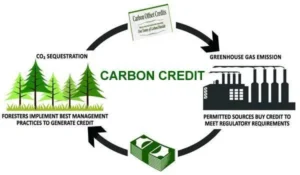GS 3 – Environment

- Launched under the Energy Conservation (Amendment) Act, 2022 and notified in 2023.
- Aims to create a domestic carbon market to meet India’s Net Zero 2070 target and NDC commitments.
- Implemented by the Bureau of Energy Efficiency (BEE) under the Ministry of Power, with oversight from the Central Electricity Regulatory Commission (CERC).
Features
- Market Mechanism:
- Entities reducing GHG emissions below prescribed targets earn carbon credits.
- Those exceeding limits must buy credits to comply.
- Carbon Credit Certificate:
- A tradable instrument issued by BEE for verified emission reductions.
- Can be bought/sold on approved exchanges (e.g., IEX, PXIL).
- Coverage:
- Initially focuses on energy-intensive sectors (power, steel, cement, fertilizers).
- Gradually expands to other industries and even voluntary markets.
- Integration:
- Aligns with existing schemes like Perform, Achieve and Trade (PAT), Renewable Energy Certificates (REC), and Energy Efficiency Financing Platform (EEFP).
Objectives
- Promote cost-effective decarbonisation.
- Incentivise industries to adopt cleaner technologies.
- Mobilise green finance through market-based mechanisms.
- Position India in the emerging global carbon market.
Benefits
- Provides flexibility for industries to meet emission targets.
- Generates additional revenue for companies investing in energy efficiency and renewables.
- Encourages innovation and private sector participation in climate action.
Challenges
- Need for robust MRV (Monitoring, Reporting, Verification) framework to prevent double counting/greenwashing.
- Risk of market volatility and speculative trading.
- Balancing domestic development priorities with global carbon pricing pressures.
- Requires capacity-building for smaller industries to participate.




